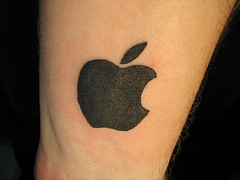
I’m in the midst of marking ITGS portfolios and have come across the term ‘digital tattoo’ – I am sure has been around for æons but clearly I missed it until now.
“Just like a tattoo, your digital reputation is an expression of yourself. It’s highly visible, and hard to remove.”
Another piece of the parent-lecture jigsaw falls into place. Here’s a snippet from my parent / teacher-of-high-school-students lecture repertoire: ‘Remember, oh young ones, a tattoo is more of a commitment than marriage and a baby; a marriage you can get out off (I think you just change your status on Facebook these days) and a baby will eventually grow up and leave (redirecting email elsewhere and un-following you on Twitter); however, a tattoo is for life.’
We all know getting a digital tattoo is so much quicker, cheaper and infinitely more permanent than a real one. And what’s worse, what are the chances of getting digitally tattooed without even knowing about it? What would you do if you suddenly discovered a full-sleeve Amy Winehouse makeover on one of your arms, a spread eagle on your back and the Union Jack in a place that the sun don’t shine? Well, at least you can cover up or fork out for laser treatment….whereas a digital tattoo is there for the world to see whenever and wherever…remaining online forever.
So some questions to ponder…
- If you had to have a digital tattoo, what would it be?
- How many unwanted digital tattoos do you have? Or should I ask, how many unwanted digital tattoos are you aware of?
- How can we prevent unwanted digital tattoos?
To help answer the last question, please go this this resource, the Digital Tattoo Project, which is being developed with grant funding from the University of British Columbia’s Teaching and Learning Enhancement Fund and from BC Campus. The goal of this site and the Digital Tattoo project is to share resources to encourage you to think about your presence online, navigate the issues involved in forming and re-forming your digital identity and learn about your rights and responsibilities as a digital citizen.
Be First to Comment